Hulme Barracks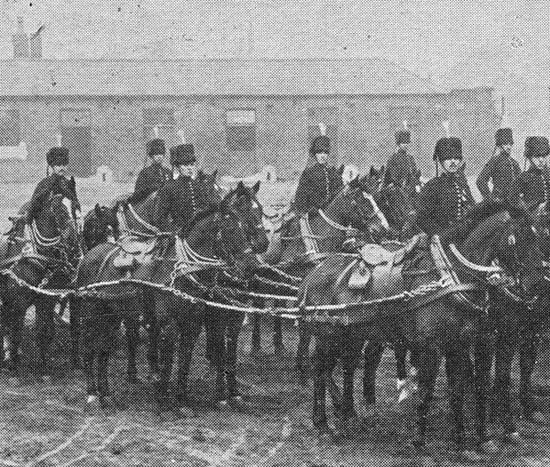 If you drive out of the
city centre along Chester Road you will pass the
impressive St. George's Church on your right. Once
the centre of a thriving community the church fell into
decline in the 1980's as the population fell and after
sitting empty for many years it was converted into
luxury apartments.
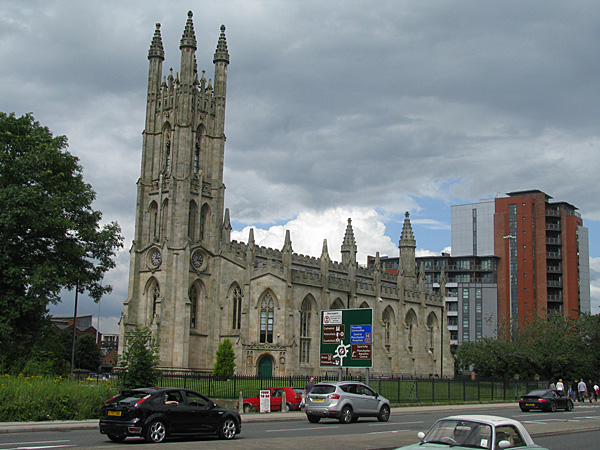 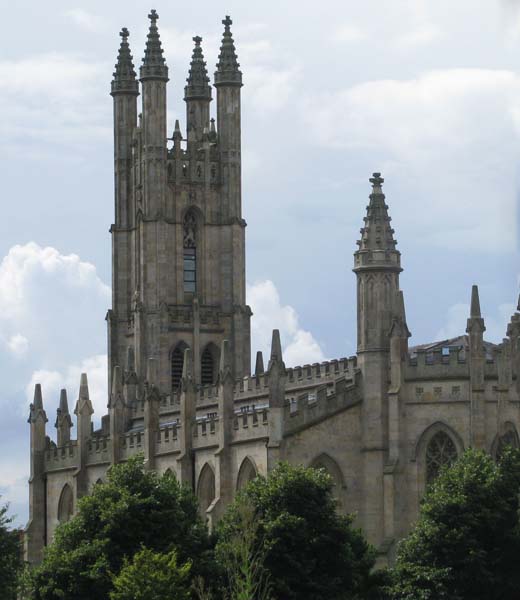 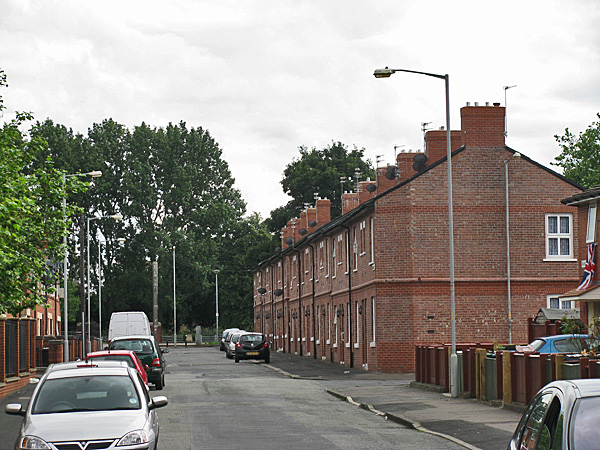 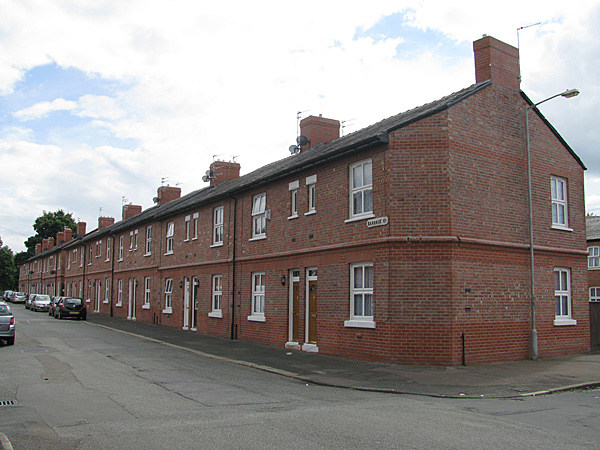 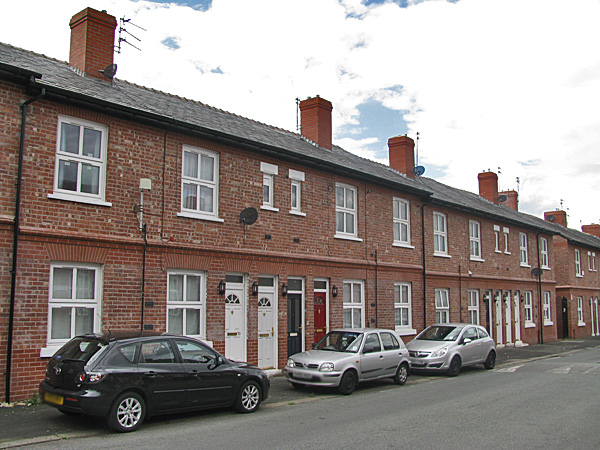 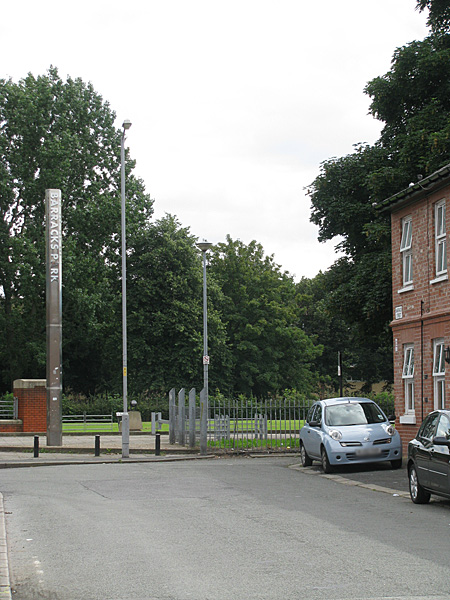 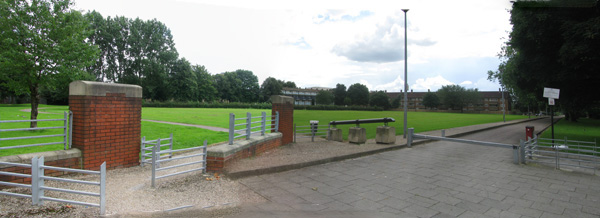 Once known as St. George's Park it was renamed in 1994 after a restoration project that improved the football pitch and added play equipment. Other than the name of the street and the park there are no indications today that the park was once a cavalry barracks accommodating several hundred men and horses. 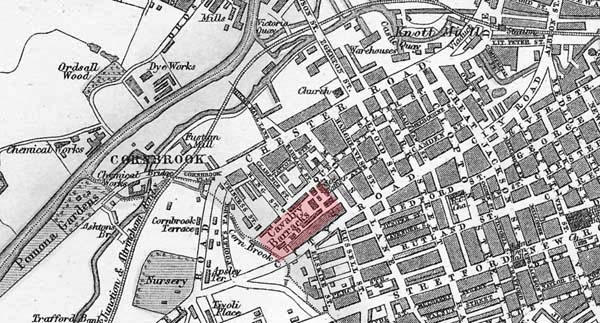 Map
provided by The
Probert Encyclopaedia
I have found conflicting dates for the opening of the Hulme Barracks but one reasonable suggestion is 1817. During the almost 100 years of its existance it was home to a number of regiments including 15th Hussars, the 11th Hussars, the 2nd Heavy Dragoons, the 14th Light Dragoons, 7th Dragoon Guards, and the 17th Lancers. The barracks covered an area of 11 acres and upwards of 300 men and horses were housed there. 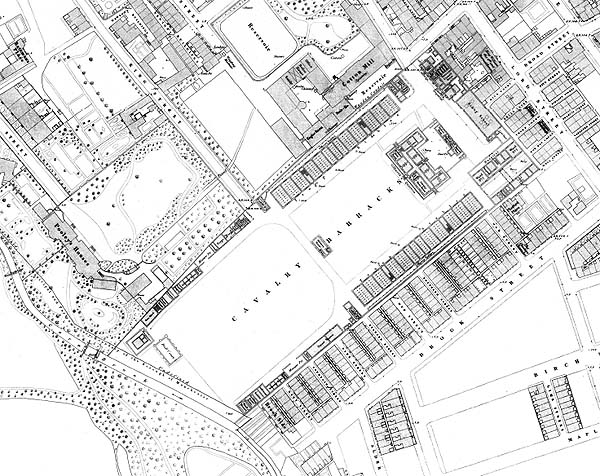 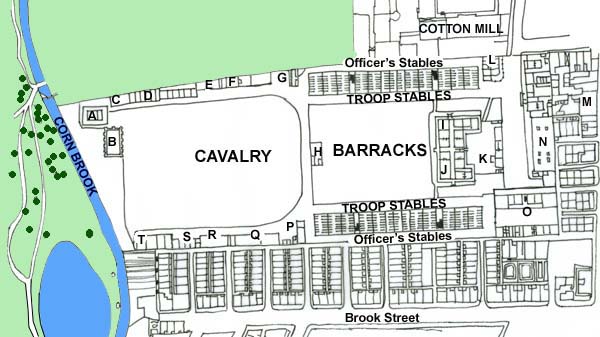 Above: my sketch from the 1844 map
In the images below you can see the barracks in 1904 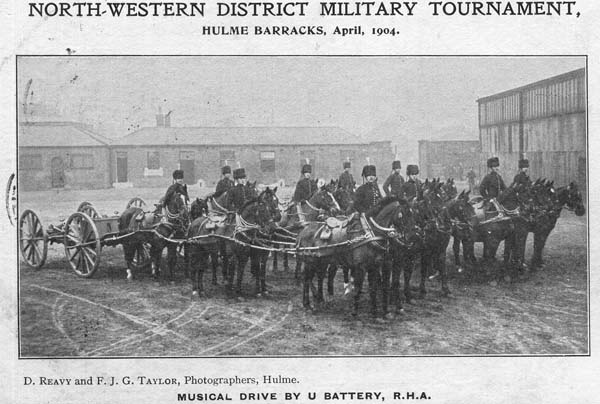 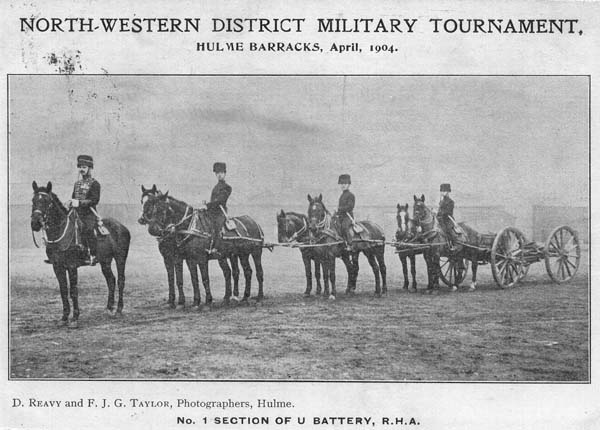 An excerpt from the
Encyclopaedia Britannica in 1911 describes a cavalry
barracks as follows:
"The barrack blocks are arranged to
suit the organization of the regiment, and are placed so
that the men can turn out readily and get to their
horses. Detached buildings are provided for cavalry
troop stables, one block for the horses of each troop.
Formerly stables were often built for convenience with
the barrack-rooms over them; but this system has been
abandoned on sanitary grounds, to the benefit of both
men and horses (Note:
old photographs of the stables at Hulme Barracks
indicate that they did have living accommodation above
the stables) . Each horse is given 1500 cub.
ft. of air space, the horses' heads are turned to the
outer walls, and provision is made, by traversed
air-ducts below the mangers, for fresh air to be
supplied to the horses while lying down. Above the
horses' heads are windows which are arranged to open
inwards, being hinged at the bottom and fitted with
hopper checks to avoid direct draught. Ridge ventilation
and skylights are given, so that all parts of the stable
are well lighted and airy.
Cast-iron mangers and hay-racks are
provided, and the horses are separated by bails, with
chains to manger brackets and heel posts; saddle
brackets are fixed to the heel posts. Each stable has a
troop store, where spare saddles and gear are kept; also
an expense forage store, in which the day's ration,
after issue in bulk from the forage barn, is kept until
it is given out in feeds.
The
space between the blocks of stables is paved with
cement concrete to form a yard, and horse-troughs,
litter-sheds and dung-pits are provided. Officers'
stables are built in separate blocks, and usually have
only one row of stalls; the stalls are divided by
partitions, and separate saddle-rooms are provided.
Stalls and loose boxes in infirmary stables give 2000
cub. ft. of air space per horse and are placed at some
distance from the troop stables in a separate
enclosure. A forge and shoeing shed is provided in a
detached block near the troop stables. A forage barn
and granary is usually built to hold a fortnight's
supply, and a chaff-cutter driven by horse power is
fixed close by. Cavalry regiments each have a large
covered riding school, and a number of open areas for
exercise and riding instruction."
******************
The 15th Hussars was one of the regiments stationed at
Hulme Barracks and in 1819 they were involved in the
infamous "Peterloo Massacre" in nearby Peter's
Field. A large political rally being held on
Peter's Field (the site of the Free Trade Hall)
attracted a crowd estimated to be in the region of
60,000. Many of the people in the crowd were women
and children in their Sunday best out for an exciting
day to hear some of the great political campaigners of
the day. The topic for the meeting was the call
for a reform of parliamentary representation. Even
before the event started local magistrates were anxious
about the crowd getting out of control and had requested
the presence in the city of a large number of police and
soldiers. As the crowd grew the magistrates became
increasingly nervous. They first ordered the
police to form a cordon around the speaker's stage and
then they sent soldiers to arrest the speakers.
When it became clear that the police and soldiers were
themselves in danger, the situation escalated out of
control. 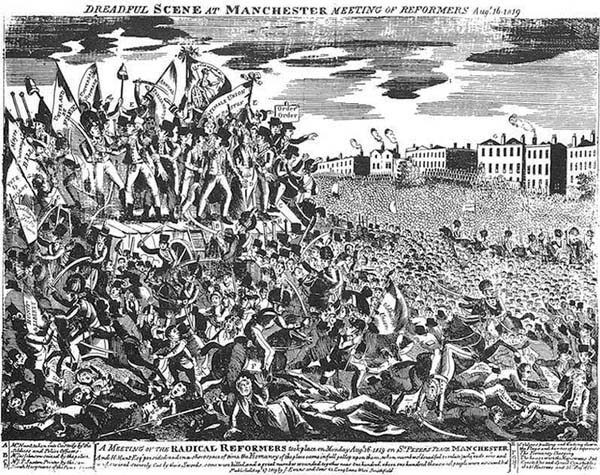 The
image above is from the Wikimedia Commons
website and is shown here on the understanding
that it is in the Public Domain. If this
isn't the case hopefully someone will bring this
to my attention and I will remove it.
Here is an account of what happened next from the commander of the 15th Hussars, Lieutenant Jolliffe. Some 60 members of the 15th Hussars were apparently sitting on Deansgate waiting for orders: "A platform had been erected near the centre of the field, from which Mr. Hunt and others were to address the multitude, and the magistrates, having ordered a strong body of constables to arrest the speakers, unfortunately imagined that they should support the peace officers by bringing up the troop of Yeomanry at a walk. We arrived at St. Peter's Field with Colonel L'Estrange. It was then for the first time that I saw the Manchester troop of Yeomanry; they were scattered singly, or in small groups over the greater part of the field, literally hemmed up and hedged into the mob so that they were powerless either to make an impression or to escape. The small body of horsemen were entirely at the mercy of the people by whom they were, on all sides, pressed upon and surrounded. It only required a glance to discover their helpless position, and the necessity of our being brought to the rescue. The Hussars drove the people forward with the flats of their swords, but sometimes, as is almost inevitably the case when men are placed in such situations, the edge was used, both by the Hussars and, as I have heard, by the Yeoman also; but I believe nine out of ten of the sabre wounds were caused by the Hussars. I still consider that it redounds to the humane forbearance of the men of the 15th that more wounds were not received, when the vast numbers are taken into consideration with whom they were brought into hostile collision; beyond all doubt, however, the far greater amount of injuries were from the pressure of the routed multitude." "Carriages were brought to convey the wounded to the Manchester Infirmary. For some time the town was patrolled by the troops, the streets being nearly empty, and the shops for the most part closed. We then returned to the barracks." Fifteen people died that day and estimates suggest that between 400 and 700 were injured, some severely. ******************* An article about the preparations for the war in the Crimea in the Australian newspaper the Hobarton Mercury of Wednesday, August 9, 1854 made reference to the Hulme Barracks: "On Tuesday, May 9th, a squadron of the 1st Royal Dragoons left Manchester for Prescott, en route for Liverpool, - thence to embark in the Gertrune and Pedestrian, cavalry transports, for the seat of war. The detachment consisted of a hundred and two non-commissioned officers and privates, with sixteen officers chargers, and eighty-one troop horses, under the command of Colonel Yorke, and accompanied by Captain Elmsal, Lieutenant Coney, Cornets Glyn, Robertson, and Sandeman, Ser- jeant Major Trip, and Surgeon Barron. This regiment has been stationed in Manchester since August, 1852. Shortly before 8 o'clock, the detachment of dragoons appeared on the parade ground, at the Cavalry Barracks, Hulme, fully equipped, and in marching order, the men in excellent spirits, and their steeds in fine condition. They went through their evolutions in the presence of a number of their friends, who had come to bid them farewell. There was much hurried grasping of hands, as the men rode out of the barrack-yard, and a lusty parting cheer was given by their friends and comrades, which was repeated by the crowd of people who watched their progress down Chester road and Egerton Street. One of the famous events of that war was The Charge of the Light Brigade. In his book, "Forgotten Heroes: The Charge of the Light Brigade", John Dutton has an account of the life of Private John Richardson who died in the Crumpsall Workhouse in 1897. "During the Charge he was in the Cornet Roger Palmer's troop where he fought beyond the Russian guns receiving two woulds in his left arm from Cossack lances." .... "In an interview with the penny paper "Spy" in June 1892 he stated his age was 63 living in Crumpsall Workhouse: "Some 34 years ago when I was in Hulme Barracks I was absent for six days, and the adjutant (John Yates) called me a scamp when I returned. I replied, I am not like you - a coward. I saw you run from a mounted Cossack; and further you never went down in the charge. After this I was up to my neck in trouble and eventually I was tried and got fifty lashes and ordered to be imprisoned. My bad back took ways and festered and I was in hospital for 28 days. During that time a letter was sent out of the hospital to an editor, was published, describing how they flogged me in the riding school, like a dog. The Colonel employed lawyers and endeavored to get the writer's name, but the editor would not give way. My father being an educated man, wrote to the Duke of Cambridge, and he ordered me to be liberated and discharged at once. In 1863 I sailed for America and enlisted in the New Jersey Volunteers, and fought in the Battle of Pittsburg." ******************** On the 21st of July in 1896 a
question was posed by MR. W. J. GALLOWAY, the member for
Manchester, S.W., regarding the Hulme Baracks:
"I beg to ask the Under Secretary of
State for War whether it has been decided to demolish
the Hulme Cavalry Barracks, Manchester, and Regent Road
Infantry Barracks, Salford, and in time sell the sites
upon which these barracks stand; whether it is intended
to maintain the garrison in the future at the same
strength as has been the case in the past.
MR. BRODRICK No decision to sell these sites has
been arrived at. The whole question of barrack
accommodation and the necessary garrison for Manchester
and Salford is at present under consideration."
It seems that the barracks continued for another 18 years and finally closed and was demolished in 1914. |